Effect of Synchronization Between Millihertz Geomagnetic Field Variations and Human Heart Rate Oscillations During Strong Magnetic Storms
Abstract
1. Introduction
2. Materials and Methods
2.1. Collection of Experimental Data
2.2. Geomagnetic Data
2.3. Analysis Procedure
- 1.
- The wavelet transformation of a 100-point segment of the HR series, within the tested periods of T = 3, …, 50 min, produces a 2-D matrix of wavelet coefficients (W(HR)s) of size i × 100, where i ranges from 1 to 50. It is worth noting that the association between i and T is monotonous but non-linear;
- 2.
- We calculated the arithmetic mean of the values in each row i (i = 1, …, 50) of the wavelet matrix W(HR) and obtained the average values of the amplitudes of each period for 100 min of the experiment (vector [g], size 1 × 50). Then, we normalized the vector [g] to its maximum value to facilitate a comparison of their shapes. For the series of geomagnetic H-component vector, we similarly computed the matrix and vector [h];
- 3.
- As a scalar quantity characterizing the degree of similarity/difference between the spectra of the HR and H GMF series, we calculated the values Q = (g,h)/|g|∙|h|. The Q parameter’s mathematical meaning equates to the cosine of the angle between [g] and [h] or their correlation coefficient, which has values ranging from −1 to 1. However, neighboring values of these vectors are not autonomous; hence, conventional algorithms for measuring statistical significance cannot apply to them. Therefore, we chose the limit of the Q parameter value that would indicate co-directionality between two vectors and similarity in the corresponding spectra empirically, i.e., at the Q ≥ 0.4 level.
3. Results
3.1. The Dst Index Dynamics During the Observation Intervals
3.2. Synchronicity of Geomagnetic Variations According to Data from Different Stations
3.3. Biogeosynchronization Effect and the Parameters of the Geomagnetic Environment
4. Discussion
- 1.
- The spectra of variations in the HR and H-component in the GMF series coincided in 42 out of 61 of the experiments considered (69%). This value of the frequency of effect occurrence is much higher than the average value that we obtained earlier for the total sample of experiments for all the years of observations (more than 600 ECG records from 10 volunteers, over 12 years, in several geographic locations) [83,86]. In all three observation intervals, the highest percentage of synchronization cases corresponded to the MS recovery phase, i.e., the first and second days after the global maximum of the magnetic storm; however, in none of the cases could the strong magnetic storm be considered as isolated. We can assume that the high value of the frequency of the effect occurrence obtained in this study can be explained by the parameters of the geomagnetic situation during the observations, which practically did not include moments of quiet GMF. Earlier, when analyzing a sample of 508 ECG records, we found that the frequency of the biogeosynchronization effect occurrence did not depend on the GMA level estimated by the daily value of the Kp-index [83]. However, the same Kp level can correspond to the main phase of the MS, the recovery phase, and to a short-term disturbance such as a substorm. Our new results show that the Kp-index used in our previous paper to describe the geomagnetic situation was apparently not specific enough to analyze the effect under study;
- 2.
- At some points in time, the observed phases of the oscillations of the H-component of the GMF in the ULF range coincided with an accuracy of 1 min at distances of up to 1700 km (the distance between the Nurmijarvi and Surlari). This coincidence is sufficient for the conclusions arising from the data of the MOS station to coincide with similar conclusions for stations significantly remote in latitude in almost 90% of the experiments considered. If further research confirms the validity of this observation with respect to certain geophysical situations, this fact may have methodological significance for further studies of the effect of biogeosynchronization in the ULF range;
- 3.
- A close correlation was found between the pairs of geomagnetic environment characteristics considered: Dst-Rp(NUR-SUA) and Dst-Ampl (NUR) were positive in the first case and negative in the second. The results obtained show the importance of taking into account the correlation between these geomagnetic features in further heliobiological studies; this may explain why some studies observe a dependence of the biogeosynchronization effect on the general GMA level during the measurement period [77];
- 4.
- The higher the correlation coefficient Rp between the time series of the H-component according to the data of distant stations, the higher the observed level of biogeophysical synchronization Q in different experiments at that time (Rs = 0.531, p < 0.00001). This was much higher than correlations observed with the other two considered characteristics of the geomagnetic environment. In the pair of Q-Ampl indicators, the correlation was statistically insignificant (p = 0.1), in the Q-Dst index, the significance level was p = 0.014. Given the correlation between these characteristics of the geomagnetic environment, we can assume that the correlation found between Q and the Dst index is indirect.
- 1.
- The database of the ECG records that we previously collected (more than 600 records) allow for additional analyses of manifestations of the biogeosynchronization effect in terms of the coincidences of oscillation phases and the amplitudes of ULF variations;
- 2.
- It is necessary to verify to what extent the conclusions on the nature of the correlations between the Dst, Rp, Ampl indices and a number of other geomagnetic indices obtained here are maintained or modified in different geomagnetic situations including, as follows: (a) during periods of “magnetic silence” (extremely low GMA levels); (b) during average GMA levels (Kp = 1–3) without pronounced geomagnetic disturbances; and (c) during other strong MS events of different classes, such as G3-G5 MS, etc.
Limitations and Advantages of the Study
5. Conclusions
Author Contributions
Funding
Institutional Review Board Statement
Informed Consent Statement
Data Availability Statement
Acknowledgments
Conflicts of Interest
Abbreviations
| MS | Magnetic Storms |
| GMF | Geomagnetic Field |
| HR | Heart Rate |
| ULF | Ultra-Low Frequency |
| PC | Pulsation Continuous |
| GMA | Geomagnetic Activity |
| CME | Coronal Mass Ejections |
| CIR | Corotating Interaction Region |
References
- Gnevyshev, M.N.; Novikova, K.F.; Ohl, A.I.; Tokareva, N.V. Sudden death from cardiovascular diseases and solar activity. In Influence of Solar Activity on the Atmosphere and Biosphere of the Earth; Nauka: Moscow, Russia, 1971; pp. 179–187. (In Russian) [Google Scholar]
- Dorman, L.I.; Iucci, N.; Ptitsyna, N.G.; Villoresi, G. Cosmic rays as indicator of space weather influence on frequency of infract myocardial, brain strokes, car and train accidents. In Proceedings of the 27th International Cosmic Ray Conference, Hamburg, Germany, 7–15 August 2001; p. 3511. [Google Scholar]
- Villoresi, G.; Breus, T.K.; Dorman, L.I.; Iuchi, N. Effect of interplanetary and geomagnetic disturbances on the increase in number of clinically serious medical pathologies (myocardial infarct and stroke). Biofizika 1995, 40, 983–993. [Google Scholar] [PubMed]
- Cornelissen, G.; Halberg, F.; Breus, T.; Syitkina, E.; Baevsky, R.; Weydahl, A.; Watanabe, Y.; Otsuka, K.; Siegelova, J.; Fiser, B.; et al. Non-photic solar assotiations of heart rate variability and myocardial infarction. J. Atmos. Sol.-Terr. Phys. 2002, 64, 707–720. [Google Scholar] [CrossRef]
- Stoupel, E.; Domarkiene, S.; Radishauskas, R.; Abramson, E. Sudden cardiac death and geomagnetic activity: Links to age, gender and agony time. J. Basic Clin. Physiol. Pharmacol. 2002, 13, 11–21. [Google Scholar] [CrossRef] [PubMed]
- Dimitrova, S.; Stoilova, I.; Georgieva, K.; Taseva, T.; Jordanova, M.; Maslarov, D. Solar and geomagnetic activity and acute myocardial infarction morbidity and mortality. Fundam Space Res. 2009, 3, 161–165. [Google Scholar]
- Mendoza, B.; de la Pena, S.S. Solar activity and human health at middle and low geomagnetic latitudes in Central America. Adv. Space Res. 2010, 46, 449–459. [Google Scholar] [CrossRef]
- Lowell, W.E.; Davis, G.E., Jr. The effect of solar cycles on human lifespan in the 50 United states: Variation in light affects the human genome. Med. Hypotheses 2010, 75, 17–25. [Google Scholar] [CrossRef]
- Vieira, C.L.Z.; Janot-Pacheco, E.; Lage, C.; Pacini, A.; Koutrakis, P.; Cury, P.R.; Shaodan, H.; Pereira, L.A.; Saldiva, P.H.N. Long-term association between the intensity of cosmic rays and mortality rates in the city of Sao Paulo. Environ. Res. Lett. 2018, 13, 24009. [Google Scholar] [CrossRef]
- Vieira, C.L.Z.; Alvares, D.; Blomberg, A.; Schwartz, J.; Coull, B.; Huang, S.; Koutrakis, P. Geomagnetic disturbances driven by solar activity enhance total and cardiovascular mortality risk in 263 U.S. cities. Environ. Health 2019, 18, 83. [Google Scholar] [CrossRef]
- Davis, G.E., Jr.; Davis, M.J.; Lowell, W.E. The effect of ultraviolet radiation on the incidence and severity of major mental illness using birth month, birth year, and sunspot data. Heliyon 2022, 8, e09197. [Google Scholar] [CrossRef]
- Qammar, N.W.; Petronaitis, D.; Jokimaitis, A.; Ragulskis, M.; Smalinskas, V.; Žiubrytė, G.; Jaruševičius, G.; Vainoras, A.; McCraty, R. Long Observation Window Reveals the Relationship between the Local Earth Magnetic Field and Acute Myocardial Infarction. Atmosphere 2023, 14, 1234. [Google Scholar] [CrossRef]
- Vencloviene, J.; Babarskiene, R.; Slapikas, R.; Sakalyte, G. The association between phenomena on the sun, geomagnetic activity, meteorological variables, and cardiovascular characteristic of patients with myocardial infarction. Int. J. Biometeorol. 2013, 57, 797–804. [Google Scholar] [CrossRef] [PubMed]
- Katsavrias, C.; Preka-Papadema, P.; Moussas, X.; Apostolou, T.; Theodoropoulou, A.; Papadima, T. Helio-geomagnetic influence in cardiological cases. Adv. Space Res. 2013, 51, 96–106. [Google Scholar] [CrossRef]
- Stupishina, O.M.; Golovina, E.G.; Noskov, S.N.; Eremin, G.B.; Gorbanev, S.A. The Space and Terrestrial Weather Variations as Possible Factors for Ischemia Events in Saint Petersburg. Atmosphere 2022, 13, 8. [Google Scholar] [CrossRef]
- Vencloviene, J.; Babarskiene, R.M.; Kiznys, D. A possible association between space weather conditions and the risk of acute coronary syndrome in patients with diabetes and the metabolic syndrome. Int. J. Biometeorol. 2017, 61, 159–167. [Google Scholar] [CrossRef]
- Vencloviene, J.; Beresnevaite, M.; Cerkauskaite, S.; Ragaisyte, N.; Pilviniene, R.; Benetis, R. Statistical Associations between Geomagnetic Activity, Solar Wind, Cosmic Ray Intensity, and Heart Rate Variability in Patients after Open-Heart Surgery. Atmosphere 2022, 13, 1330. [Google Scholar] [CrossRef]
- Schiff, J.E.; Vieira, C.L.Z.; Garshick, E.; Wang, V.; Blomberg, A.; Gold, D.R.; Schwartz, J.; Tracy, S.M.; Vokonas, P.; Koutrakis, P. The role of solar and geomagnetic activity in endothelial activation and inflammation in the NAS cohort. PLoS ONE 2022, 17, e0268700. [Google Scholar] [CrossRef]
- Dimitrova, S. Relationship between human physiological parameters and geomagnetic variations of solar origin. Adv. Space Res. 2006, 37, 1251–1257. [Google Scholar] [CrossRef]
- Vencloviene, J.; Braziene, A.; Dobozinskas, P. Short-Term Changes in Weather and Space Weather Conditions and Emergency Ambulance Calls for Elevated Arterial Blood Pressure. Atmosphere 2018, 9, 114. [Google Scholar] [CrossRef]
- Mavromichalaki, H.; Papailiou, M.; Dimitrova, S.; Babayev, E.S.; Loucas, P. Space weather hazards and their impact on human cardio-health state parameters on Earth. Nat. Hazards 2012, 64, 1447–1459. [Google Scholar] [CrossRef]
- Galata, E.; Ioannidou, S.; Papailiou, M.; Mavromichalaki, H.; Paravolidakis, K.; Kouremeti, M.; Trachanas, K. Impact of space weather on human heart rate during the years 2011–2013. Astrophys. Space Sci. 2017, 362, 138. [Google Scholar] [CrossRef]
- Papailiou, M.; Ioannidou, S.; Tezari, A.; Lingri, D.; Konstantaki, M.; Mavromichalaki, H.; Dimitrova, S. Space weather phenomena on heart rate: A study in the Greek region. Int. J. Biometeorol. 2023, 67, 37–45. [Google Scholar] [CrossRef] [PubMed]
- Oinuma, S.; Kubo, Y.; Otsuka, K.; Yamanaka, T.; Murakami, S.; Matsuoka, O.; Ohkawa, S.; Cornélissen, G.; Weydahl, A.; Holmeslet, B.; et al. Graded response of heart rate variability, associated with an alteration of geomagnetic activity in a subarctic area. Biomed. Pharmacother. 2002, 56, 284–288. [Google Scholar] [CrossRef] [PubMed]
- Dimitrova, S.; Angelov, I.; Petrova, E. Solar and geomagnetic activity effects on heart rate variability. Nat. Hazards 2013, 69, 25–37. [Google Scholar] [CrossRef]
- Janashia, K.; Tvildiani, L.; Tsibadze, T.; Invia, N. Effects of the geomagnetic field time varying components compensation as evidenced by heart rate variability of healthy males. Life Sci. Space Res. 2022, 32, 38–44. [Google Scholar] [CrossRef]
- Vieira, C.L.Z.; Chen, K.; Garshick, E.; Liu, E.M.; Vokonas, P.; Ljungman, P.; Schwartz, J.; Koutrakis, P. Geomagnetic disturbances reduce heart rate variability in the normative aging study. Sci. Total Environ. 2022, 839, 156235. [Google Scholar] [CrossRef]
- Stoupel, E. Cardiac arrhythmia and geomagnetic activity. Indian Pacing Electrophysiol. J. 2006, 6, 49–53. Available online: https://www.ncbi.nlm.nih.gov/pmc/articles/PMC1501097/ (accessed on 1 December 2024).
- Papailiou, M.; Mavromichalaki, H.; Vassilaki, A.; Kelesidis, K.M.; Mertzanos, G.A.; Petropoulos, B. Cosmic ray variations of solar origin in relation to human physiological state during December 2006 solar extreme events. Adv. Space Res. 2009, 43, 523–529. [Google Scholar] [CrossRef]
- Breus, T.K.; Cornélissen, G.; Halberg, F.; Levitin, A.E. Temporal associations of life with solar and geophysical activity. Ann. Geophys. 1995, 13, 1211–1222. [Google Scholar] [CrossRef]
- Stoupel, E.; Kalediene, R.; Petrauskiene, J.; Starkuviene, S.; Abramson, E.; Israelevich, P.; Sulkes, J. Twenty years study of solar, geomagnetic, cosmic ray activity links with monthly deaths number (n-850304). J. Biomed. Sci. Eng. 2011, 4, 426. [Google Scholar] [CrossRef]
- Stoupel, E.; Babayev, E.; Abramson, E.; Sulkes, J. Days of “zero” level geomagnetic activity accompanied by the high neutron activity and dynamics of some medical events—Antipodes to geomagnetic storms. Health 2013, 5, 855–861. [Google Scholar] [CrossRef]
- Podolská, K. Circulatory and Nervous Diseases Mortality Patterns—Comparison of Geomagnetic Storms and Quiet Periods. Atmosphere 2022, 13, 13. [Google Scholar] [CrossRef]
- Gurfinkel’, I.; Kuleshova, V.P.; Oraevskiĭ, V.N. Assessment of the effect of a geomagnetic storm on the frequency of appearance of acute cardiovascular pathology. Biofizika 1998, 43, 654–658. (In Russian) [Google Scholar] [PubMed]
- Kleimenova, N.G.; Kozyreva, O.V.; Breus, T.K.; Rapoport, S.I. Pc1 geomagnetic pulsations as a potential hazard of the myocardial infarction. J. Atmos. Sol. Terr. Phys. 2007, 69, 1759–1764. [Google Scholar] [CrossRef]
- Ozheredov, V.A.; Breus, T.K.; Gurfinkel, Y.I.; Revich, B.A.; Mitrofanova, T.A. Influence of some weather factors and geomagnetic activity on the development of severe cardiological pathologies. Biophysics 2010, 55, 110–119. Available online: https://link.springer.com/article/10.1134%2FS0006350910010185 (accessed on 1 December 2024). [CrossRef]
- Shaposhnikov, D.; Revich, B.; Gurfinkel, Y.; Naumova, E. The influence of meteorological and geomagnetic factors on acute myocardial infarction and brain stroke in Moscow, Russia. Int. J. Biometeorol. 2013, 58, 799–808. [Google Scholar] [CrossRef]
- Sasonko, M.L.; Ozheredov, V.A.; Breus, T.K.; Ishkov, V.N.; Klochikhina, O.A.; Gurfinkel, Y.I. Combined influence of the local atmosphere conditions and space weather on three parameters of 24-h electrocardiogram monitoring. Int. J. Biometeorol. 2019, 63, 93–105. [Google Scholar] [CrossRef]
- Papailiou, M.-C.; Ioannidou, S.; Tezari, A.; Mavromichalaki, H. Geomagnetic and Cosmic Ray Activity Effect on Heart Rate during the Solar Cycle 24. Atmosphere 2024, 15, 158. [Google Scholar] [CrossRef]
- Zenchenko, T.A.; Poskotinova, L.V.; Rekhtina, A.G.; Zaslavskaya, R.M. Relation between Microcirculation Parameters and Pc3 Geomagnetic Pulsations. Biophysics 2010, 55, 646–651. [Google Scholar] [CrossRef]
- Golovanova, I.L.; Filippov, A.A.; Chebotareva, Y.V.; Urvantseva, G.A.; Krylov, V.V. Effect of a Shift in Diurnal Geomagnetic Variation on the Activity and Sensitivity of Digestive Glycosidases in Roach Underyearlings to Heavy Metals. Izv. Atmos. Ocean. Phys. 2019, 55, 1623–1628. [Google Scholar] [CrossRef]
- Krylov, V.V.; Kantserova, N.P.; Lysenko, L.A.; Osipova, E.A. A simulated geomagnetic storm unsynchronizes with diurnal geomagnetic variation affecting calpain activity in roach and great pond snail. Int. J. Biometeorol. 2019, 63, 241–246. [Google Scholar] [CrossRef]
- Timofejeva, I.; McCraty, R.; Atkinson, M.; Joffe, R.; Vainoras, A.; Alabdulgader, A.; Ragulskis, M. Identification of a Group’s Physiological Synchronization with Earth’s Magnetic Field. Int. J. Environ. Res. Public Health 2017, 14, 998. [Google Scholar] [CrossRef] [PubMed]
- Timofejeva, I.; McCraty, R.; Atkinson, M.; Alabdulgader, A.A.; Vainoras, A.; Landauskas, M.; Šiaučiūnaitė, V.; Ragulskis, M. Global Study of Human Heart Rhythm Synchronization with the Earth’s Time Varying Magnetic Field. Appl. Sci. 2021, 11, 2935. [Google Scholar] [CrossRef]
- Ramishvili, A.; Janashia, K.; Tvildiani, L. High Heart Rate Variability Causes Better Adaptation to the Impact of Geomagnetic Storms. Atmosphere 2023, 14, 1707. [Google Scholar] [CrossRef]
- Babayev, E.S.; Allahverdiyeva, A.A. Effects of geomagnetic activity variations on the physiological and psychological state of functionally healthy humans: Some results of Azerbaijani studies. Adv. Space Res. 2007, 40, 1941–1951. [Google Scholar] [CrossRef]
- Gurfinkel, Y.I.; Vasin, A.L.; Pishchalnikov, R.Y.; Sarimov, R.M.; Sasonko, M.L.; Matveeva, T.A. Geomagnetic storm under laboratory conditions: Randomized experiment. Int. J. Biometeorol. 2018, 62, 501–512. [Google Scholar] [CrossRef]
- Shepoval'nikov, V.N.; Soroko, S.I. Human Meteo Sensitivity; Ilim: Bishkek, Kyrgyzstan, 1992; p. 247. (In Russian) [Google Scholar]
- Krylov, V.V. Biological effects related to geomagnetic activity and possible mechanisms. Bioelectromagnetics 2017, 38, 497–510. [Google Scholar] [CrossRef]
- Zenchenko, T.A.; Medvedeva, A.A.; Khorseva, N.I.; Breus, T.K. Synchronization of human heart-rate indicators and geomagnetic field variations in the frequency range of 0.5–3.0 mHz. Izv. Atmos. Ocean. Phys. 2014, 50, 736–744. [Google Scholar] [CrossRef]
- Task Force of the European Society of Cardiology and the North American Society of Pacing and Electrophysiology. Heart rate variability: Standards of measurement, physiological interpretation and clinical use. Circulation 1996, 93, 1043–1065. [Google Scholar] [CrossRef]
- Shaffer, F.; McCraty, R.; Zerr, C. A healthy heart is not a metronome: An integrative review of the heart’s anatomy and heart rate variability. Front. Psychol. 2014, 5, 1040. [Google Scholar] [CrossRef]
- McCraty, R.; Shaffer, F. Heart Rate Variability: New Perspectives on Physiological Mechanisms, Assessment of Self-regulatory Capacity, and Health risk. Glob. Adv. Health Med. 2015, 4, 46–61. [Google Scholar] [CrossRef]
- Grishin, V.G.; Grishin, O.V.; Gultyaeva, V.V.; Zinchenko, M.I.; Uryumtsev, D.Y. Very-Low-Frequency Oscillations of Oxygen Transport in Resting Humans. Russ. J. Physiol. 2019, 105, 1154–1162. [Google Scholar] [CrossRef]
- Tankanag, A.V.; Grinevich, A.A.; Tikhonova, I.V.; Chemeris, N.K. An Analysis of Phase Relationships between Oscillatory Processes in the Human Cardiovascular System. Biophysics 2020, 65, 159–164. [Google Scholar] [CrossRef]
- Hayano, J.; Yuda, E. Assessment of autonomic function by long-term heart rate variability: Beyond the classical framework of LF and HF measurements. J. Physiol. Anthropol. 2021, 40, 21. [Google Scholar] [CrossRef] [PubMed]
- Stein, P.K.; Lundequam, E.J.; Clauw, D.; Freedland, K.E.; Carney, R.M.; Domitrovich, P.P. Circadian and ultradian rhythms in cardiac autonomic modulation. Conf. Proc. IEEE Eng. Med. Biol. Soc. 2006, 2006, 429–432. [Google Scholar] [CrossRef]
- Zenchenko, T.A.; Medvedeva, A.A.; Potolitsyna, N.N.; Parshukova, O.I.; Boiko, E.R. Correlation of the dynamics of minute-scale heart rate oscillations and biochemical parameters of the blood in healthy subjects to Pc5–6 geomagnetic pulsations. Biophysics 2015, 60, 309–316. [Google Scholar] [CrossRef]
- Kleiger, R.E.; Miller, J.P.; Bigger, J.T., Jr.; Moss, A.J. Decreased heart rate variability and its association with increased mortality after acute myocardial infarction. Am. J. Cardiol. 1987, 59, 256–262. [Google Scholar] [CrossRef]
- Cattaneo, L.A.; Franquillo, A.C.; Grecucci, A.; Beccia, L.; Caretti, V.; Dadomo, H. Is Low Heart Rate Variability Associated with Emotional Dysregulation, Psychopathological Dimensions, and Prefrontal Dysfunctions? An Integrative View. J. Pers. Med. 2021, 11, 872. [Google Scholar] [CrossRef]
- Bigger, J.T., Jr.; Fleiss, J.L.; Steinman, R.C.; Rolnitzky, L.M.; Kleiger, R.E.; Rottman, J.N. Frequency domain measures of heart period variability and mortality after myocardial infarction. Circulation 1992, 85, 164–171. [Google Scholar] [CrossRef]
- Carney, R.M.; Freedland, K.E.; Stein, P.K.; Miller, G.E.; Steinmeyer, B.; Rich, M.W.; Duntley, S.P. Heart rate variability and markers of inflammation and coagulation in depressed patients with coronary heart disease. J. Psychosom. Res. 2007, 62, 463–467. [Google Scholar] [CrossRef]
- Rapoport, S.I.; Boldypakova, T.D.; Malinovskaia, N.K.; Oraevskiĭ, V.N.; Meshcheriakova, S.A.; Breus, T.K.; Sosnovskiĭ, A.M. Magnetic storms as a stress factor. Biofizika 1998, 43, 632–639. (In Russian) [Google Scholar]
- Otsuka, K.; Yamanaka, T.; Cornelissen, G.; Breus, T.; Chibisov, S.M.; Baevsky, R.; Siegelová, J.; Fiser, B.; Halberg, F. Altered chronome of heart rate variability during span of high magnetic activity. Scr. Medica 2000, 73, 111–116. [Google Scholar]
- Otsuka, K.; Cornélissen, G.; Weydahl, A.; Holmeslet, B.; Hansen, T.L.; Shinagawa, M.; Kubo, Y.; Nishimura, Y.; Omori, K.; Yano, S.; et al. Geomagnetic disturbance associated with decrease in heart rate variability in a subarctic area. Biomed. Pharmacother. 2001, 55, 51–56. [Google Scholar] [CrossRef] [PubMed]
- Otsuka, K.; Oinuma, S.; Cornélissen, G.; Weydahl, A.; Ichimaru, Y.; Kobayashi, M.; Yano, S.; Holmeslet, B.; Hansen, T.L.; Mitsutake, G.; et al. Alternating Light-Darkness-Influenced Human Electrocardiographic Magnetoreception in Association with Geomagnetic Pulsations. Biomed. Pharmacother. 2001, 55, 63–75. [Google Scholar] [CrossRef] [PubMed]
- Alabdulgader, A.; McCraty, R.; Atkinson, M.; Dobyns, Y.; Stolc, V.; Ragulskis, M. Long-term study of heart rate variability responses to changes in the solar and geomagnetic environment. Sci. Rep. 2018, 8, 2663. [Google Scholar] [CrossRef]
- Gmitrov, J.; Ohkubo, C. Geomagnetic field decreases cardiovascular variability. Electro Magnetobiol. 1999, 18, 291–303. [Google Scholar] [CrossRef]
- Caswell, J.M.; Singh, M.; Persinger, M.A. Simulated sudden increase in geomagnetic activity and its effect on heart rate variability: Experimental verification of correlation studies. Life Sci. Space Res. 2016, 10, 47–52. [Google Scholar] [CrossRef]
- Lednev, V.V.; Belova, N.A.; Ermakov, A.M.; Akimov, E.B.; Tonevitsky, A.G. Modulation of cardiac rhythm in the humans exposed to extremely weak alternating magnetic fields. Biophysics 2008, 53, 648–654. [Google Scholar] [CrossRef]
- Vasin, A.L.; Shafirkin, A.V.; Gurfinkel, Y.I. Effect of artificial alternating geomagnetic field in the millihertz range on the heart rate variability indices. Aviakosmicheskaya I Ekol. Meditsina 2019, 53, 62–69. (In Russian) [Google Scholar] [CrossRef]
- Lukyanova, S.N. Neuroeffects of Microwave EMF Range of Non-Thermal Intensity and Short Exposure. Radiat. Biology. Radioecol. 2024, 64, 244–256. [Google Scholar] [CrossRef]
- Halberg, F.; Cornelissen, G.; Otsuka, K.; Watanabe, Y.; Katinas, G.S.; Burioka, N.; Delyukov, A.; Gorgo, Y.; Zhao, Z.; Weydahl, A.; et al. Cross-spectrally coherent ~10,5- and 21-year biological and physical cycles, magnetic storms and myocardial infarctions. Neuroendocrinol. Lett. 2000, 21, 233–258. [Google Scholar]
- Presman, A.S. Electromagnetic Field and Wildlife; Nauka: Moscow, Russia, 1968; p. 310. (In Russian) [Google Scholar]
- McCraty, R.; Atkinson, M.; Timofejeva, I.; Joffe, R.; Vainoras, A.; Landauskas, M.; Alabdulgader, A.; Ragulskis, M. The influence of heart coherence on synchronization between human heart rate variability and geomagnetic activity. J. Complex. Health Sci. 2018, 1, 42–48. [Google Scholar] [CrossRef]
- Poskotinova, L.; Krivonogova, E.; Demin, D.; Zenchenko, T. Differences in the Sensitivity of the Baroreflex of Heart Rate Regulation to Local Geomagnetic Field Variations in Normotensive and Hypertensive Humans. Life 2022, 12, 1102. [Google Scholar] [CrossRef] [PubMed]
- Pobachenko, S.V.; Kolesnik, A.G.; Borodin, A.S.; Kalyuzhin, V.V. The contingency of parameters of human encephalograms and Schumann resonance electromagnetic fields revealed in monitoring studies. Biophysics 2006, 51, 480–483. [Google Scholar] [CrossRef]
- Kleimenova, N.G.; Gromova, L.I.; Gromov, S.V.; Malysheva, L.M. Large Magnetic Storm on September 7–8, 2017: High-Latitude Geomagnetic Variations and Geomagnetic Pc5 Pulsations. Geomagn. Aeron. 2018, 58, 597–606. [Google Scholar] [CrossRef]
- Kleimenova, N.G.; Gromova, L.I.; Gromov, S.V.; Malysheva, L.M. The Magnetic Storm of August 25–26, 2018: Dayside High Latitude Geomagnetic Variations and Pulsations. Geomagn. Aeron. 2019, 59, 660–667. [Google Scholar] [CrossRef]
- Tsurutani, B.T.; Zank, G.P.; Sterken, V.J.; Shibata, K.; Nagai, T.; Mannucci, A.J. Space Plasma Physics: A Review. IEEE Trans. Plasma Sci. 2023, 51, 1595–1655. [Google Scholar] [CrossRef]
- Viall, N.M.; Kepko, L.; Spence, H.E. Relative occurrence rates and connection of discrete frequency oscillations in the solar wind density and dayside magnetosphere. J. Geophys. Res. 2009, 114, A01201. [Google Scholar] [CrossRef]
- Klibanova, Y.Y.; Mishin, V.V.; Tsegmed, B.; Moiseev, A.V. Properties of daytime long-period pulsations during magnetospheric storm commencement. Geomagn. Aeron. 2016, 56, 426–440. [Google Scholar] [CrossRef]
- Zenchenko, T.A.; Khorseva, N.I.; Breus, T.K. Long-Term Study of the Synchronization Effect between Geomagnetic Field Variations and Minute-Scale Heart-Rate Oscillations in Healthy People. Atmosphere 2024, 15, 134. [Google Scholar] [CrossRef]
- Hajra, R.; Tsurutani, B.T.; Lakhina, G.S.; Lu, Q.; Du, A. Interplanetary causes and impacts of the 2024 May superstorm on the geosphere: An overview. Astrophys. J. 2024, 974, 264. [Google Scholar] [CrossRef]
- Smolentsev, N.K. Fundamentals of wavelet theory. In Wavelets in MATLAB; DMK Press: Moscow, Russia, 2009; p. 448. [Google Scholar]
- Zenchenko, T.A.; Khorseva, N.I.; Stankevich, A.A. The Effect of Synchronizing the Human Heart Rhythm with Geomagnetic Field Variations: Are There Particular Frequencies? Biophysics 2024, 69, 792–802. [Google Scholar]
- Elhalel, G.; Price, C.; Fixler, D.; Shainberg, A. Cardioprotection from stress conditions by weak magnetic fields in the Schumann resonance band. Sci. Rep. 2019, 9, 1645. [Google Scholar] [CrossRef] [PubMed]
- Grinberg, M.; Mudrilov, M.; Kozlova, E.; Sukhov, V.; Sarafanov, F.; Evtushenko, A.; Ilin, N.; Vodeneev, V.; Price, C.; Mareev, E. Effect of extremely low-frequency magnetic fields on light-induced electric reactions in wheat. Plant Signal. Behav. 2022, 17, 2021664. [Google Scholar] [CrossRef] [PubMed]
- Anagnostopoulos, G.; Basta, M.; Stefanakis, Z.; Vassiliadis, V.; Vgontzas, A.; Rigas, A.; Koutsomitros, S.; Baloyannis, S.; Papadopoulos, G. A study of correlation between seismicity and mental health: Crete, 2008–2010. Geomat. Nat. Hazards Risk 2013, 6, 45–75. [Google Scholar] [CrossRef]
- Cherry, N. Schumann Resonances, a plausible biophysical mechanism for the human health effects of Solar. Nat. Hazards 2002, 26, 279–331. [Google Scholar] [CrossRef]
- Krylov, V.V.; Osipova, E.A. Molecular Biological Effects of Weak Low-Frequency Magnetic Fields: Frequency–Amplitude Efficiency Windows and Possible Mechanisms. Int. J. Mol. Sci. 2023, 24, 10989. [Google Scholar] [CrossRef]
- Moiseev, A.V.; Baishev, D.G.; Barkova, E.S.; Du, A.; Yumoto, K. Specific features of the generation of long-periodic geomagnetic pulsations in the event on June 25, 2008. Cosmic. Res. 2015, 53, 111–118. [Google Scholar] [CrossRef]
- Kozyreva, O.; Pilipenko, V.; Engebretson, M.J.; Yumoto, K.; Watermann, J.; Romanova, N. In search of a new ULF wave index: Comparison of Pc5 power with dynamics of geostationary relativistic electrons. Planet. Space Sci. 2007, 55, 755–769. [Google Scholar] [CrossRef]

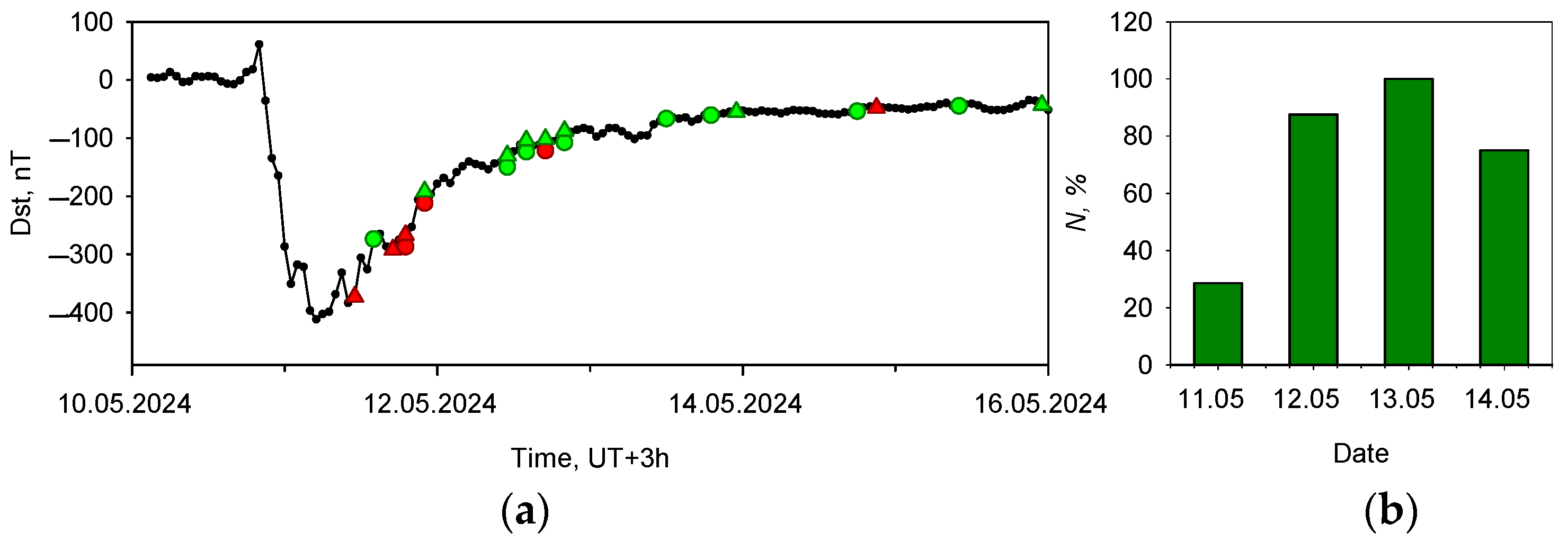
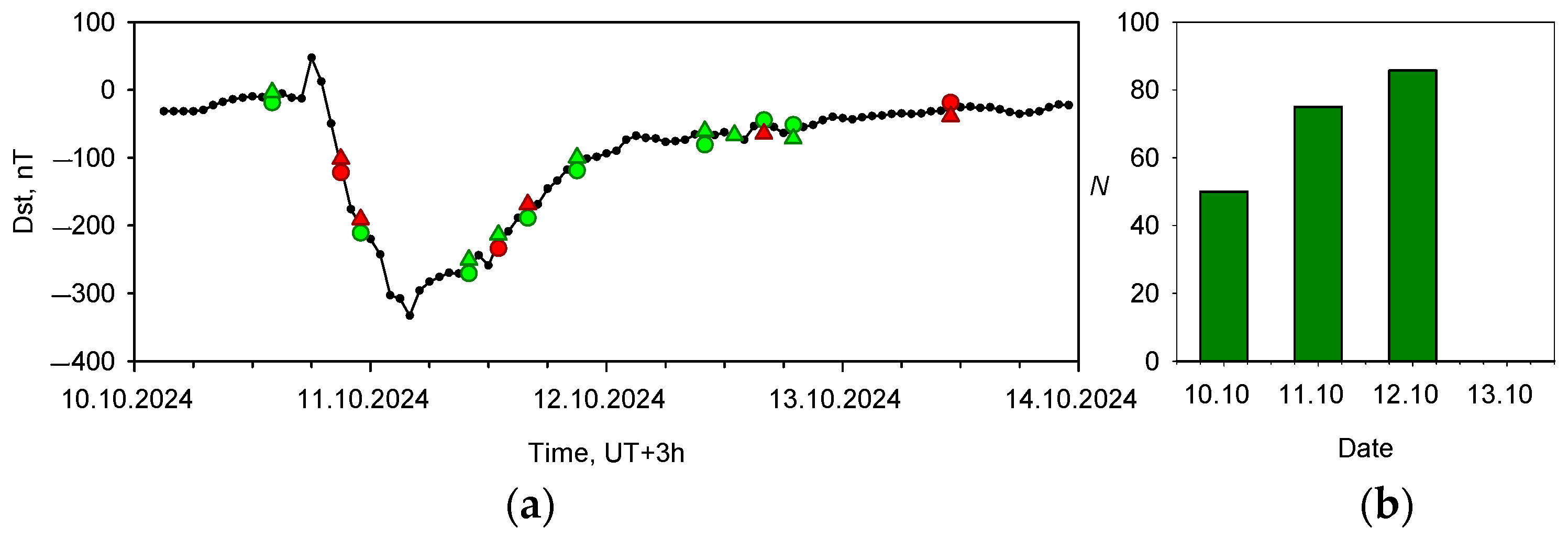
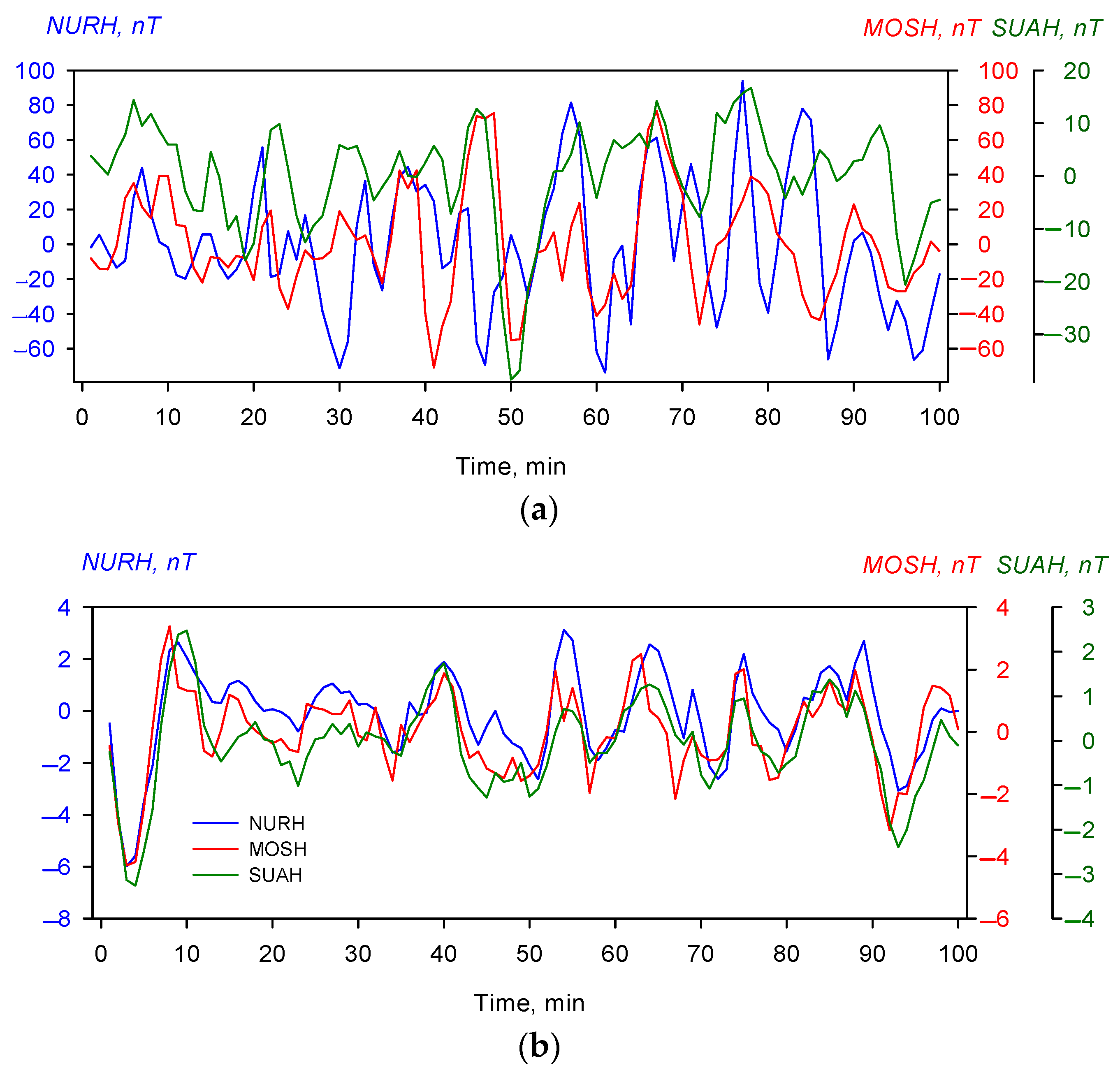
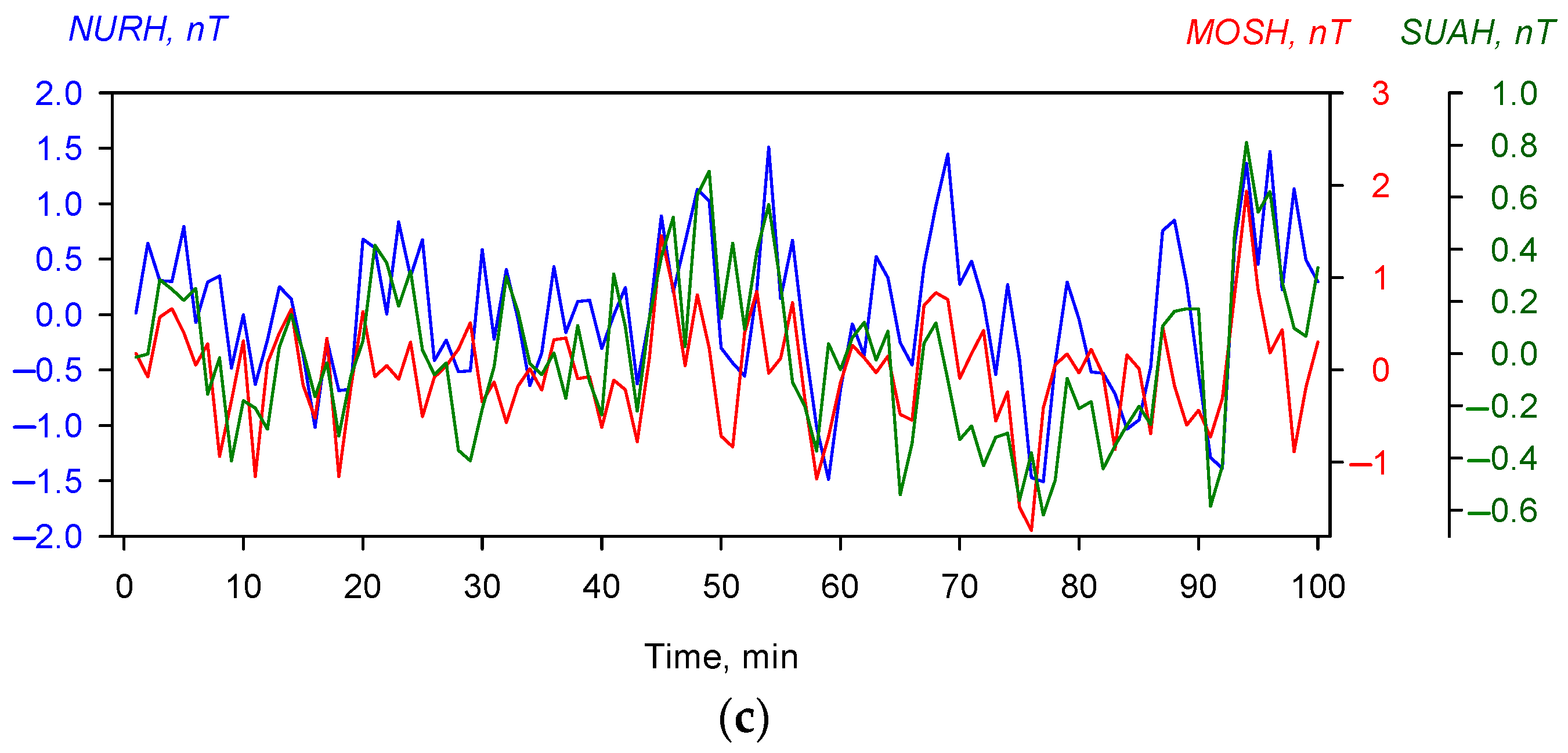
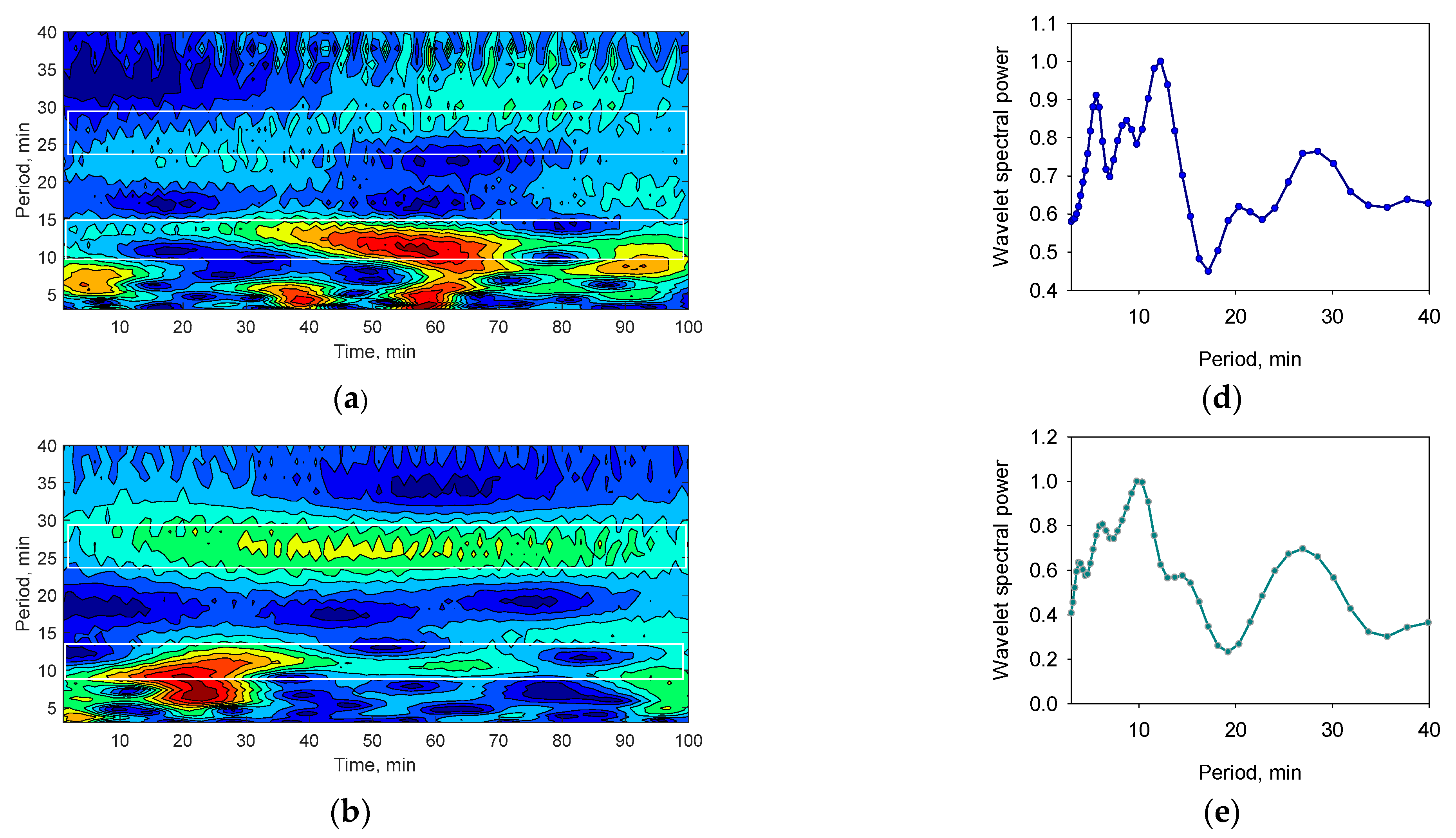


| All | Vol A | Vol B | 09/2023 | 05/2024 | 10/2024 | |
|---|---|---|---|---|---|---|
| n | 61 | 39 | 22 | 16 | 22 | 23 |
| Rs (Q-Rp) | 0.531 | 0.457 | 0.679 | 0.291 | 0.625 | 0.562 |
| p(Q-Rp) | 10−5 | 0.003 | 0.0005 | 0.273 | 0.0014 | 0.004 |
| Rs(Q-Ampl) | −0.214 | −0.162 | −0.385 | 0.438 | −0.323 | −0.284 |
| p(Q-Ampl) | 0.098 | 0.323 | 0.076 | 0.091 | 0.133 | 0.177 |
| Rs(Q-Dst) | 0.313 | 0.305 | 0.534 | 0.385 | 0.442 | 0.136 |
| p(Q-Dst) | 0.014 | 0.059 | 0.010 | 0.141 | 0.035 | 0.525 |
Disclaimer/Publisher’s Note: The statements, opinions and data contained in all publications are solely those of the individual author(s) and contributor(s) and not of MDPI and/or the editor(s). MDPI and/or the editor(s) disclaim responsibility for any injury to people or property resulting from any ideas, methods, instructions or products referred to in the content. |
© 2025 by the authors. Licensee MDPI, Basel, Switzerland. This article is an open access article distributed under the terms and conditions of the Creative Commons Attribution (CC BY) license (https://creativecommons.org/licenses/by/4.0/).
Share and Cite
Zenchenko, T.A.; Khorseva, N.I.; Breus, T.K.; Drozdov, A.V.; Seraya, O.Y. Effect of Synchronization Between Millihertz Geomagnetic Field Variations and Human Heart Rate Oscillations During Strong Magnetic Storms. Atmosphere 2025, 16, 219. https://doi.org/10.3390/atmos16020219
Zenchenko TA, Khorseva NI, Breus TK, Drozdov AV, Seraya OY. Effect of Synchronization Between Millihertz Geomagnetic Field Variations and Human Heart Rate Oscillations During Strong Magnetic Storms. Atmosphere. 2025; 16(2):219. https://doi.org/10.3390/atmos16020219
Chicago/Turabian StyleZenchenko, Tatiana A., Natalia I. Khorseva, Tamara K. Breus, Andrey V. Drozdov, and Olga Y. Seraya. 2025. "Effect of Synchronization Between Millihertz Geomagnetic Field Variations and Human Heart Rate Oscillations During Strong Magnetic Storms" Atmosphere 16, no. 2: 219. https://doi.org/10.3390/atmos16020219
APA StyleZenchenko, T. A., Khorseva, N. I., Breus, T. K., Drozdov, A. V., & Seraya, O. Y. (2025). Effect of Synchronization Between Millihertz Geomagnetic Field Variations and Human Heart Rate Oscillations During Strong Magnetic Storms. Atmosphere, 16(2), 219. https://doi.org/10.3390/atmos16020219








